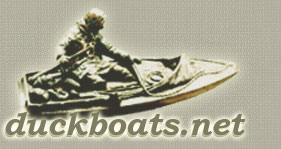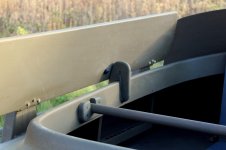Steve Sanford
Well-known member
Good morning, All~
Over the years, I have made several sets of flap boards for South Bay Duckboats. Making the boards is straightforward. More challenging is mounting them to the vessel. The original flap boards on South Bays were mounted via hinges to 2x4 blocks bolted through the deck. I have replaced most of the mounting blocks that have come my way, making them larger and more soundly fastened. I also like to make them so that the boards will lay level when down - so decoys can be set on them when setting out or picking up the rig.
I have probably posted at least parts of my process previously - but I just came across this folder of images - and got an inquiry from Luke Krucher here on duckboats.
The first thing is to measure the bevel of the mounting surface. The blocks themselves will be plumb - so a level across the coamings on a boat that is level on saw horses - gives a good reading with a bevel gauge.
View attachment 1 Block bevel.jpg
I use stock at least 2 inches thick - either Mahogany or Locust (shown here). Each block is shaped and marked (port or stbd, fwd or aft) and drilled BEFORE sawing the bevel.
The bevel is cut on the table saw. The "cut-offs" - the bottom halves - are used as the backer blocks for the through-bolts. This allows the washers and nuts to make up square to the backers.
View attachment 2 New Blocks.jpg
I usually seal the block with epoxy - followed by duckboat paint. Here is a set for a different vessel. Although sealed and painted, these have not yet been drilled or beveled.
View attachment Flap Boards 03 blocks.JPG
I use galvanized (hot-dipped) hinges with brass pins - or solid brass. Two quarter-inch carriage bolts pass through the each, its block and its backer - and are fastened from below with a fender washer and nut.
View attachment sm 8 Hinges and cbolts.jpg
It is important that the blocks be aligned fore and aft so the hinges do not bind. A straight edge is clamped to the blocks so the bolt holes can be located properly.
View attachment 7 Aligning blocks.JPG
Everything gets thoroughly bedded in 3M 5200 during installation. The 5200 should be wiped thoroughly after fastening so it will not need to be removed after curing.
View attachment sm 9 Mounted and sealed.jpg
Here is another alternative - using the original mounting blocks - which were treated 2x4 stock. These blocks have been reinstalled - bedded in 5200 - with 1/2-inch plywood backers below decks.
I added the third block to support the flap board level. The cleat is handy for lashing the boat sideways against the bog - using bog spikes.
BTW: These flap boards are about 12 inches tall - as is the new spray shield - which is also wider than the original. The flap boards are fastened to the hinges with brass FH machine screws - with acorn nuts on the inner/upper side of the boards.
View attachment sm FB 31 installed.JPG
Hope this helps!
SJS
Over the years, I have made several sets of flap boards for South Bay Duckboats. Making the boards is straightforward. More challenging is mounting them to the vessel. The original flap boards on South Bays were mounted via hinges to 2x4 blocks bolted through the deck. I have replaced most of the mounting blocks that have come my way, making them larger and more soundly fastened. I also like to make them so that the boards will lay level when down - so decoys can be set on them when setting out or picking up the rig.
I have probably posted at least parts of my process previously - but I just came across this folder of images - and got an inquiry from Luke Krucher here on duckboats.
The first thing is to measure the bevel of the mounting surface. The blocks themselves will be plumb - so a level across the coamings on a boat that is level on saw horses - gives a good reading with a bevel gauge.
View attachment 1 Block bevel.jpg
I use stock at least 2 inches thick - either Mahogany or Locust (shown here). Each block is shaped and marked (port or stbd, fwd or aft) and drilled BEFORE sawing the bevel.
The bevel is cut on the table saw. The "cut-offs" - the bottom halves - are used as the backer blocks for the through-bolts. This allows the washers and nuts to make up square to the backers.
View attachment 2 New Blocks.jpg
I usually seal the block with epoxy - followed by duckboat paint. Here is a set for a different vessel. Although sealed and painted, these have not yet been drilled or beveled.
View attachment Flap Boards 03 blocks.JPG
I use galvanized (hot-dipped) hinges with brass pins - or solid brass. Two quarter-inch carriage bolts pass through the each, its block and its backer - and are fastened from below with a fender washer and nut.
View attachment sm 8 Hinges and cbolts.jpg
It is important that the blocks be aligned fore and aft so the hinges do not bind. A straight edge is clamped to the blocks so the bolt holes can be located properly.
View attachment 7 Aligning blocks.JPG
Everything gets thoroughly bedded in 3M 5200 during installation. The 5200 should be wiped thoroughly after fastening so it will not need to be removed after curing.
View attachment sm 9 Mounted and sealed.jpg
Here is another alternative - using the original mounting blocks - which were treated 2x4 stock. These blocks have been reinstalled - bedded in 5200 - with 1/2-inch plywood backers below decks.
I added the third block to support the flap board level. The cleat is handy for lashing the boat sideways against the bog - using bog spikes.
BTW: These flap boards are about 12 inches tall - as is the new spray shield - which is also wider than the original. The flap boards are fastened to the hinges with brass FH machine screws - with acorn nuts on the inner/upper side of the boards.
View attachment sm FB 31 installed.JPG
Hope this helps!
SJS


